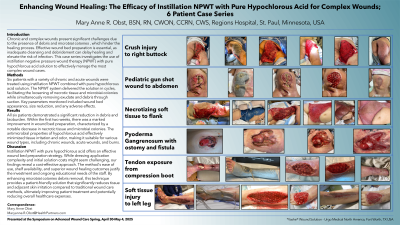Case Series/Study
(CS-114) Enhancing Wound Healing: The Efficacy of Instillation NPWT with Hypochlorous Acid for Complex Wounds; 6 Person Case Series

Chronic and complex wounds present significant challenges due to the presence of debris and biofilm, which hinder the healing process. Effective wound bed preparation is essential, as inadequate cleansing and debridement can delay healing and elevate the risk of infection. This case series investigates the use of instillation negative pressure wound therapy (NPWT) with pure hypochlorous acid solution to effectively manage the most complex wound cases.
Methods:
Six patients with a variety of chronic and acute wounds were treated using instillation NPWT combined with pure hypochlorous acid solution. The NPWT system delivered the solution in cycles, facilitating the loosening of necrotic tissue and biofilm while simultaneously removing exudate and debris through suction. Key parameters monitored included wound bed appearance, size reduction, and any adverse effects.
Results:
All six patients demonstrated a significant reduction in debris and bioburden. Within the first two weeks, there was a marked improvement in wound bed preparation, characterized by a notable decrease in necrotic tissue and biofilm. The antimicrobial properties of hypochlorous acid effectively minimized tissue irritation and odor, making it suitable for various wound types, including chronic wounds, acute wounds, and burns. Instillation NPWT with pure hypochlorous acid offers an effective wound bed preparation strategy. While dressing application complexity and initial solution costs might seem challenging, our findings reveal a cost-effective approach. The method's ease of use, shelf availability, and superior wound healing outcomes justify the investment and ongoing educational needs of the staff. By enhancing biofilm and debris removal, this technique provides a patient-friendly solution that significantly reduces tissue and adjacent skin irritation compared to traditional wound care methods, ultimately improving patient treatment and potentially reducing overall healthcare expenses.
Discussion:

.jpg)